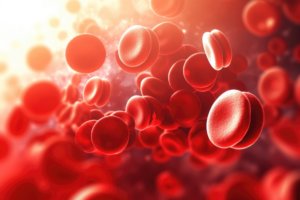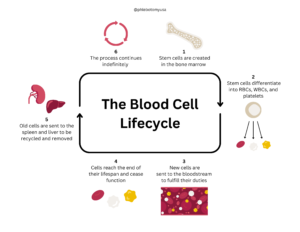27 Mar The Complete Lifecycle of Blood Cells
Inside the human body, a remarkable cycle occurs, unnoticed yet vital for life – the lifecycle of human blood cells. This process ensures that our blood can perform its essential functions, from transporting oxygen to fighting infections. In this article, we will explore the fascinating journey of blood cells. From their beginnings to end, each stage shows the crucial steps our body goes through to keep us healthy and alive. Join us as we uncover the essential processes that sustain us.
Step 1: Birth
Our journey begins in the bone marrow, the spongy tissue inside our bones. Here, stem cells (HSCs) reside, the foundation of all blood cells. These HSCs are unique because they can transform into any blood cell type.
Step 2: Differentiation
At this stage, the stem cells must commit to becoming a specific type of blood cell. They differentiate into one of three primary types: red blood cells (RBCs), white blood cells (WBCs), and platelets. The body determines this through various factors, including specialized signals and the environment.
RBCs: Formed from erythroid progenitor cells, they mature into reticulocytes and erythrocytes. This process takes about seven days. RBCs have a disk shape and lack a nucleus, optimizing them for their role in oxygen transportation.
WBCs: These come from myeloid or lymphoid lineages. Each type of WBC (like neutrophils, lymphocytes, and monocytes) has a specific function in the immune response. Their development varies from days to weeks, depending on the type.
Platelets: Formed from megakaryocytes in the bone marrow, platelets are small fragments of cells essential for blood clotting. They develop over several days.
Step 3: Deployment
Once the cells have matured, they set off into the bloodstream. Their critical missions will take them throughout the body, each type with its specific role and destination.
RBCs: RBCs travel through the body, carrying oxygen from the lungs to tissues and returning carbon dioxide for exhalation. The average lifespan of an RBC is about 120 days.
WBCs: Depending on their type, WBCs patrol the body for pathogens, provide immunity, or engage in healing processes. Their lifespan ranges from days to years, depending on their function and type.
Platelets: Circulating in the blood, platelets are always ready to respond to a bleeding injury by forming clots. They live for about 7-10 days.
Step 4: Death
As blood cells reach the end of their lifespan, the body naturally programs them to die – a process known as apoptosis. This is crucial for maintaining the balance of cell populations in the blood. This phase marks the end of the functional life of the blood cell, where they are prepared for removal and recycling.
Step 5: Recycling
Next, the old blood cells are sent to the spleen and liver – the body’s specialized recycling centers. Natural circulation and specialized body systems guide them there. The cells are broken down in the spleen and liver, and their components are reused. This is an excellent demonstration of the body’s remarkable ability to use its resources. The spleen acts as a filter, removing old and damaged RBCs and recycling their iron. The liver processes the by-products of RBC breakdown, detoxifying and excreting.
Step 6: Renewal
Even as old cells die, the bone marrow continuously produces new ones. This ongoing process ensures balance in the body. The iron and other components salvaged from old cells are reused, exemplifying the body’s efficiency in resource management.
In Conclusion
The lifecycle of blood cells is a miraculous process of birth, service, death, and renewal. It’s a testament to the body’s remarkable ability to regenerate and sustain itself, which remains crucial for survival and health. Blood cells are vital in keeping us alive and well through each stage, from birth to death.


